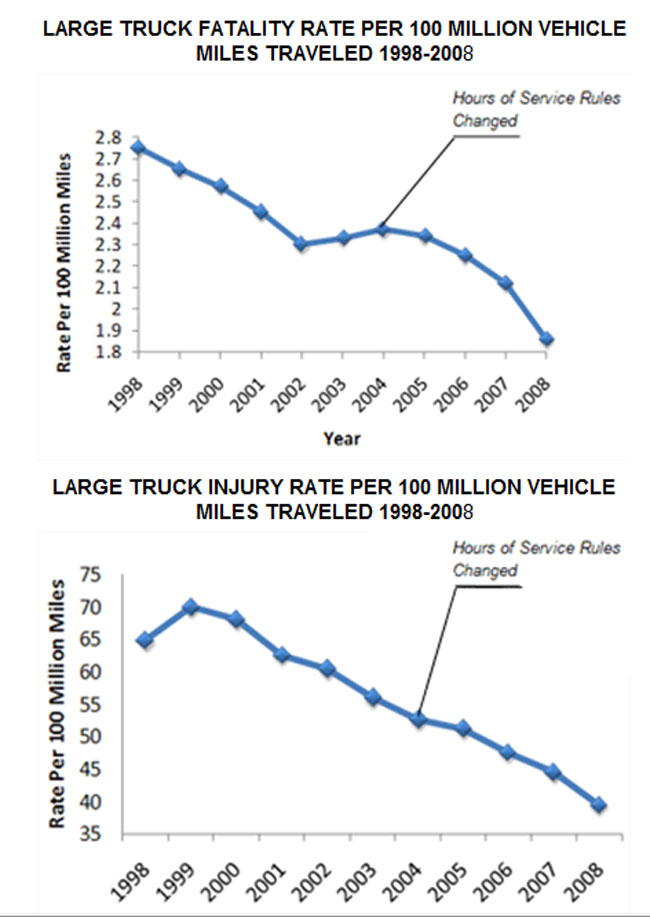From SCDigest's On-Target E-Magazine
SCDigest Editorial Staff
Jan. 4, 2011
Logistics News: Proposed New Hours of Service Rules a "Lump of Coal" in Trucking Industry's Stocking, ATA Says
New Rules Could Reduce Driving Time by an Additional Hours, Other Hits to Productivity; Fixing Something that is not Broken?
On December 29, the Obama administration published its proposal for still more changes in the Hours of Service (HOS) rules in the Federal Register, following years of complaints by some consumer groups that the 2004 HOS changes did not go far enough to protect highway safety.
According to the Federal Motor Carrier Safety Administration (FMSCA), a division of the Dept. of Transportation, the proposed rule would make six important changes from current requirements.
SCDigest Says: |
 |
| An interesting twist is that the given the safety improvements, the rules are being pitched as an effort to improve driver health, not public safety as in past HOS changes. |
|
What Do You Say?
|
|
|
|
(1) Limit drivers to either 10 or 11 hours of driving time following a period of at least 10 consecutive hours off duty - the agency is still determining its final stance, but says it "currently favors a 10-hour limit."
(2) Would limit the standard ``driving window'' to 14 hours, while allowing that number to be extended to 16 hours twice a week.
(3) Actual duty time within the driving window would be limited to 13 hours.
(4) Drivers would be permitted to drive only if 7 hours or less have passed since their last off-duty or sleeper-berth period of at least 30 minutes.
(5) The 34- hour restart would be retained, subject to certain limits: The restart would have to include two periods between midnight and 6 a.m. and could be started no sooner than 168 hours (7 days) after the beginning of the previously designated restart.
(6) The definition of ``on duty'' would be revised to allow some time spent in or on the vehicle to be logged as off duty.
There is also a seventh proposed changed that relates specifically to oil field operations.
See the full proposal in the Federal Register here: Proposed Hours of Service Changes
Comments on the proposed changes are being accepted until Feb. 28, 2011.
ATA Says Changes were a Lump of Coal for Truckers and Shippers
The American Trucking Associations, which represents carriers, lashed out against the proposal, first announced on Dec. 23, as "three big chunks of coal under trucking's Christmas tree," citing three primary problems among the six proposed changes.
The new rules, the ATA says, would likely reduce the maximum daily driving time to 10 hours; reduce the maximum daily working time window by an additional hour; and - counter to the government’s news release - abolish the 34-hour restart as it exists today.
The proposal is “overly complex, chock full of unnecessary restrictions on professional truck drivers and, at its core, [and] would substantially reduce trucking’s productivity,” said Bill Graves, President and CEO of the ATA.
It notes the trucking industry's significant and steady progress on safety under existing rules, which Graves says "has been remarkable."
The ATA says that crash-related fatalities are down 33 percent from the 2003 level, and that both fatality and injury crash rates are at their lowest level since the USDOT began keeping records. (See graphic below - it is interesting to note the HOS changes in 2004 were correlated with a downward move in fatalities.)

Source: ATA/US Dept. of Transportation
"Trucking’s never been safer," Graves says, saying "The Obama Administration’s willingness to break something that’s not broken likely has everything to do with politics and little or nothing to do with highway safety or driver health.”
An interesting twist is that the given the safety improvements, the rules are being pitched as an effort to improve driver health, not public safety as in past HOS changes.
(Transportation Management Article Continued Below)
|